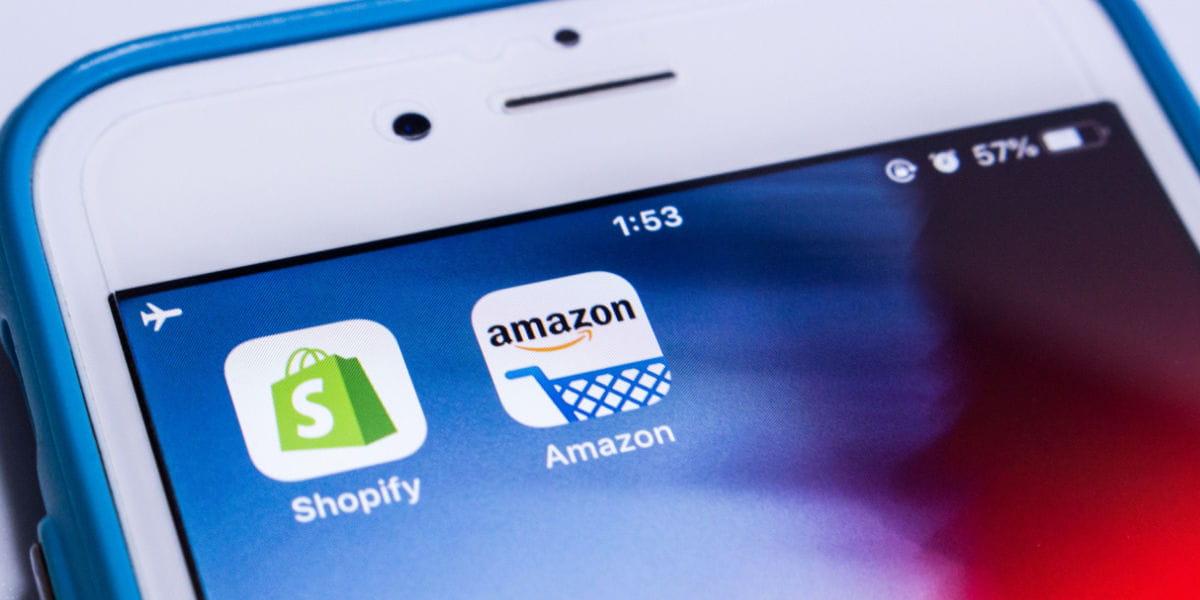
How to start an eCommerce business from home

eCommerce is all the rage in Australia right now – whether you’re dabbling in it as a side hustle or going all-in with a full-time business.
One of the major attractions to starting an eCommerce business is that you’re not tied to a physical store, and that you can tap into a rapidly expanding consumer market. The opportunities really are endless if you know where to start.
In this blog post, we will cover everything from the basics of eCommerce, what types of businesses are finding success, the challenges facing the industry, as well as some handy digital tools and marketing strategies.
So, whether you’re eager to jumpstart your entrepreneurial journey or you have a unique craft you want to share with the world, then keep reading to learn more about launching your own online business from home.
The origins of eCommerce and what online businesses sell
The origins of eCommerce began with the development of the internet in the early 1990s, but has exploded across the globe in recent years. As per market research firm Statista, the Australian eCommerce market is worth around $65.3 billion in 2023, with that number tipped to grow at a rate of 10.4%, to $96.9 billion, by 2027.
Generally, eCommerce refers to any company or individual that buys and sells goods and services over the internet. So, pretty much every type of product you could think of, whether it’s a physical product, digital product or service, can fall under eCommerce.
That’s why before starting an online business, it’s a good idea to do your homework on the local eCommerce market, and where your offering may sit within it.
Common eCommerce businesses in Australia
Most eCommerce in Australia is done via digital platforms like eBay and Amazon. A majority of the remainder is done direct to consumer at the individual company website level. Here, the largest five eCommerce stores in Australia are supermarkets Woolworths and Coles, electronics retailer Apple, retailer Kmart, and pharmacy chain Chemist Warehouse.
Outside these market leaders, other popular sites for online transactions include electronic retailer JB Hi-Fi, variety store Kogan.com, office supplies store Officeworks, liquor retailer Dan Murphy's, sports apparel company Nike, and department store Catch.
Social media is also a hot spot for eCommerce, particularly given Australia’s highly socially mobilised consumer base, which counts more than 13 million active Facebook users.
What is the best type of eCommerce business to start?
When it comes to starting an eCommerce business, determining the type that would be best for you can be overwhelming. With so many options available, it’s easy to get lost in a sea of possibilities. However, fear not, as with a bit of research, you can make an informed decision on which direction to take.
There are several factors to consider, including target audience, availability of products, and competition. The best eCommerce business for you will largely depend on your unique circumstances and preferences, but with careful thought and planning, you can choose a path that leads to success.
For instance, if you own a local grocery store, it may be difficult to compete with the likes of giant supermarkets Coles and Woolworths, which dominate the online market.
So, while it’s great to find an eCommerce business that best matches your skill set, just because you are passionate about an area doesn’t make an online store profitable.
One way to start narrowing things down is to look for gaps in the market and find ways to set yourself apart. In other words, find a niche that you could fill online using your skill set.
This is part of being strategic in identifying products or services that will cut through and find a market. Try and pinpoint specific items that appeal to a particular audience. You can get the ball rolling by making a list of products you may like to sell in your store, thinking about off-beat products that you, friends and family, colleagues, and the community would be interested in.
As mentioned, eCommerce takes in a vast array of products and services - literally thousands - making it tricky to create an exhaustive list of potentially successful home-based eCommerce businesses. Even so, according to Forbes, there are some trends that we can watch out for.
Forbes points to a disparate array of popular eCommerce businesses now, including those selling pet treats, educational platforms, handmade toys, eco-friendly baby products, online thrift stores, dessert boxes, specialty food, high-end fashion and plants.
What are the challenges of starting an eCommerce business?
Like any business in the early stages, whether online-based or brick-and-mortar, eCommerce businesses can face significant hurdles and difficulties. Here are four common challenges of starting an eCommerce business in Australia.
1. Sourcing the right products
Product sourcing is an area to watch closely. It refers to the process of buying product inventory from a supplier and then reselling them, with common sourcing methods including using a manufacturer, buying third-party goods wholesale, or dropshipping.
The right option will depend on the product you’re selling. For example, if you’re selling custom furniture, it’s likely you will be working with a manufacturer. By contrast, if you’re an electronics store, you’ll probably partner with a wholesale supplier or distributor.
For many eCommerce businesses, especially those that are home-based, dropshipping can be a simpler way to source products. Using this model, you run the internet-based shopfront, with a lot of the backend obligations undertaken by a third-party supplier. It’s up to the dropshipping partner to take care of customer orders and then fulfil and deliver the shipment. This can take a lot of the hassle out of the process for sellers.
2. Converting sales from cart to checkout
This is another common early - and ongoing - challenge, with many customers adding products to a shopping cart but then failing to follow through and complete the transaction.
If you’re finding this happening at high levels, there could be several reasons for it. These include customers ‘just looking’, comparing prices, or checking out the site before going in-store. Other possible reasons could be that your shipping costs are too high, a lack of payment options, or technical issues making payment overly difficult.
To lift conversion rates, some commonly cited methods are lowering shipping fees and making the checkout process as easy as possible, reducing so-called ‘friction’. Other tips are to fix technical glitches on the site and address reluctant buyer psychology by easing customer anxiety with clear return or guarantee policies, and social proof such as reviews.
3. Customer experience
Customer experience also poses challenges online. In eCommerce it can be a challenge to offer customers the same experience they would get in a brick-and-mortar store. Thankfully however, online businesses can still offer great customer service with a little extra work.
A strategy here includes ‘being available’ so customers can reach you 24/7, and actively listening to them. Unpacking this could mean round-the-clock customer service teams to replicate face-to-face interactions, live chat, or AI integration via chatbots.
It also pays to be clear and upfront to avoid any conflict, if possible. This means including as much website information as you can on products and policies, as well as investing enough in quality site searches so customers are able to find out what they want to know themselves.
Free shipping over a certain purchase amount is another much-heralded online customer service ploy. This approach can go a long way in building loyalty with customers while persuading them to make larger purchases.
4. Cyber security
While the eCommerce boom allows online businesses access to new customers globally, there are also massive risks due to increased threats from cybercrime like fraud.
Hence, it’s key that eCommerce businesses have policies and procedures for a solid cybersecurity framework when starting out. The reason: in case of an attack, a business does not suffer sales and operations downtime that will hit the bottom line.
Online business owners also need the proper cybersecurity framework to keep data safe and secure. Tighter access control and data security software can help both to shore up cyber defences and boost peace of mind of a hack impacting operations down the track.
How much does it cost to start an eCommerce business?
Starting an online store requires careful planning and foresight to be successful – and part of that plan should include figuring out how much money is needed upfront. Many eCommerce businesses spend more than what’s needed, especially if expenses like marketing and inventory management are not considered.
Some common overheads for operating an eCommerce business include website development, website hosting, graphic design, and more.
There’s also business insurance to pay, and the ongoing costs involved in shipping if your business relates to a physical product, and customer relationship management or labour costs.
Finally, there are physical costs related to office equipment to consider and sometimes-overlooked transaction fees, which are like a commission set by eCommerce platforms.
What equipment do you need to set up an eCommerce business?
If you plan to run your eCommerce business from home, then you’ll need to set up and optimise your home office. This means investing in some must-have items to make the transition to working from home a success.
In terms of physical office space, you’ll need the basics like a desk, chair, computer, and monitor that fit your specific professional needs, tailored to your personal specifications.
You’ll also have to acquire the right office equipment. Here, a reliable multi-function printer to create invoices and other customer-facing collateral is highly underrated.
By investing in a device such as the Brother MFC-J4540DW, you can benefit from a range of useful features, such as printing-from and scanning-to popular cloud apps, being able to connect wirelessly or via a smartphone, and undertake tasks that require automatic 2-sided printing.
Another important aspect of running an eCommerce business from home is the need to print professional-quality labels on demand. Brother’s QL-1110NWB is a versatile wide-format label printer that can be used for generating product labels, graphics, QR codes, shipping labels, and more.
How to market your eCommerce website and stand out
Getting noticed in the crowded world of eCommerce can be tough. Regardless, there are some tried and tested tactics to help your business stand out amongst the crowd.
Identify your unique selling point
With so many online stores vying for the attention of customers, how do you stand out from the crowd? It all comes down to identifying your unique selling proposition (USP). What sets you apart from your competitors? Is it your product selection? Your exceptional customer service? Your lightning-fast shipping?
Once you figure out your USP, make sure to weave it into your branding and marketing efforts. Make it clear to your customers why they should choose you over everyone else.
According to Shopify, your unique selling point should be assertive, but defensible, focused on what your specific customers value and ‘more than a slogan’.
Search engine optimisation (SEO)
In today's digital world, having a killer website is not enough. You need to get noticed, and that's where search engine optimisation (SEO) comes in. Using the right keywords can make all the difference in attracting more traffic to your site.
Essentially, SEO is about making it easy for search engines like Google and Bing to find your content and place it higher in their rankings compared to other sites. So, if you're looking to boost your online presence and get ahead of the competition, mastering SEO is a must.
As a basic rule of thumb, a key part of SEO is matching the keywords used on your website with the words and phrases customers use when they search for your product. So, in your web copy it’s a good idea to use keywords relevant to your business, services and location. However, it's best to avoid overusing keywords as this can have a negative impact on your online visibility.
Paid search and social media advertising
There’s also digital marketing spend to factor in. This may be in the form of paid search or social media advertising, or a combination of both.
Basically, paid search advertising is a type of digital marketing where organisations pay search engines like Google to position their ads higher on relevant search results page. You can think about it as aiming for the same result as SEO but a different way to get there.
By contrast, social media marketing uses platforms like Facebook, Twitter, and Instagram to market an eCommerce business’ products and services, as well as to engage with existing customers and reach out to new audiences.
Making sure customers return
In the ever-evolving world of eCommerce, attracting customers to your online business is just as important as retaining them. But with the vast array of options available to consumers, how can you make sure your online shop stands out from the crowd and keeps them coming back?
The key lies in building a long-lasting relationship with your clients, and that begins with understanding their needs and preferences. Once you have an idea of what your customers want, you can tailor your services to meet their expectations and make their shopping experience more enjoyable.
Whether it’s offering personalised discounts, providing exceptional customer service, or simplifying the checkout process, putting your clients first will not only increase their loyalty but also help you achieve long-term success as an eCommerce business.
Ready to kickstart your eCommerce business? Start off on the right foot
At Brother, we understand the challenges that come with starting an eCommerce business, and we’re here to help you succeed. Our range of print and label solutions offer all the functionality you need to streamline your business operations and make things run more smoothly.
With Brother at your side, you can focus on growing your eCommerce business and carving out a niche in the competitive online marketplace. See how we can help you on your digital journey by contacting us today.









